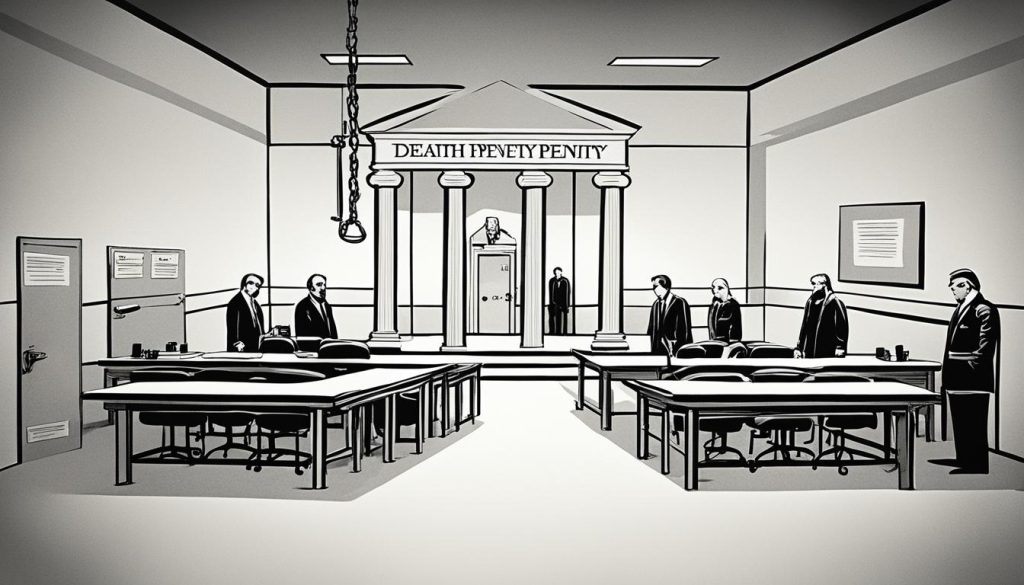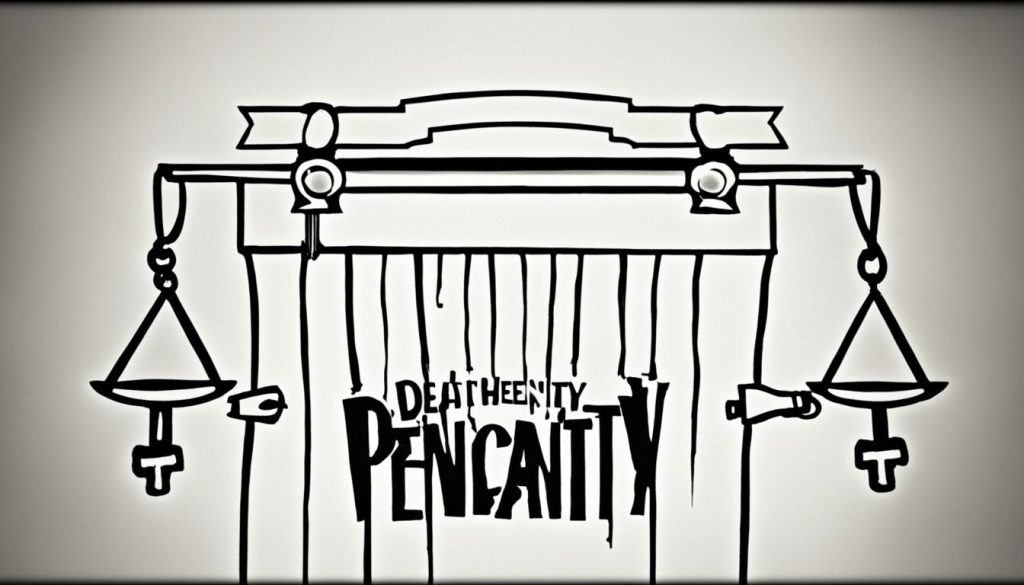The death penalty, also known as capital punishment, is when the state executes someone for a crime1. Congress and state legislatures decide who can face this punishment. The Supreme Court says it’s okay, but there are rules about how it should be done2.
The Court looks at what’s seen as fair and kind to decide if a punishment is too harsh3. The death penalty is rare at the federal level, with only 16 executions in recent times, all by lethal injection2.
Key Takeaways
- The death penalty is the state-sanctioned punishment of executing an individual for a specific crime.
- The Supreme Court has ruled that the death penalty does not violate the Eighth Amendment’s ban on cruel and unusual punishment, but the Eighth Amendment does shape certain procedural aspects.
- The federal death penalty applies in all 50 states and U.S. territories but is used relatively rarely, with 16 federal executions carried out in the modern era.
- The Supreme Court’s analysis requires considering the evolving standards of decency to determine if a particular punishment constitutes a cruel or unusual punishment.
- Congress and state legislatures can prescribe the death penalty for crimes considered capital offenses.
- https://tuneKong.com/ultimate-outdoor-furniture-hacks-style-comfort-and-durability-combined-10/
Defining the Death Penalty
The death penalty, also known as capital punishment, is the lawful execution of a person for a serious crime4. In the U.S., public executions stopped in the 1930s, showing a change in how society viewed it4. There was a big debate in the 20th century about showing executions on TV, with some countries like Guatemala doing it4. The European Union has rules against sending people to countries that use the death penalty, showing their commitment to human rights4.
Historical Context
The death penalty has a long history in the U.S. In 1972, the Supreme Court case Furman v. Georgia stopped the death penalty, saying it was cruel and unfair, especially for poor and minority communities4. But, it was brought back in 1976 with new rules in Gregg v. Georgia4. The Supreme Court said the death penalty must be fair to the crime4. In Kennedy v. Louisiana, they said it’s not okay to use the death penalty for child rape if the victim lives4.
People on death row can wait over 15 years for their execution, showing how long the process is4. Around 20 countries have had public executions since the 1990s, like Iran and Saudi Arabia, but the U.N. Human Rights Committee says it’s not right4.
The history of the death penalty in the U.S. has seen big changes in laws and society, showing the ongoing debate over it45.
| Statistic | Value |
|---|---|
| People exonerated and released from death row in the USA since 1973 | 2005 |
| People executed in the USA since 1973 | 1,5915 |
| Ratio of people executed to people exonerated | 1 in 85 |
| Percentage of Black exonerees who were victims of official misconduct | 87%5 |
| Percentage of white exonerees who were victims of official misconduct | 67%5 |
| Percentage of homicide exonerations in the USA in 2018 that involved misconduct | 79%5 |
| Record number of exonerations in the USA in 2018 involving false testimony | 1115 |
| Death sentences invalidated by courts in Alabama | Over 1605 |
| Percentage of people on death row who are African American | 41%5 |
| Percentage of executions in the USA that have occurred in the South | Over 80%5 |
| Likelihood of execution for murder of a white victim compared to a Black victim in Georgia | 17 times more likely5 |
Legal Framework and Procedures
Constitutional Considerations
The death penalty in the U.S. is under a detailed legal setup. It’s guided by the Constitution and Supreme Court decisions. For a death sentence, the jury must consider the criminal’s specific situation. The court must also ensure an individualized sentencing process6.
The Supreme Court says it’s wrong for a judge alone to decide on a death penalty factor6. If an appeals court finds a sentencing factor wrong, the death sentence is invalid unless another factor is found6. The Court also allows the death penalty if a jury finds both good and bad factors equally6.
On execution methods, the Supreme Court has said lethal injection is okay6. They use a test to see if an execution method is cruel. The Court also says executing people with severe mental disabilities is wrong6.
The Supreme Court has made key decisions on the death penalty. In Coker v. Georgia (1977), they said the punishment must match the crime6. In Roper v. Simmons (2005), they stopped the death penalty for minors because they’re not fully developed6.
The rules around the death penalty in the U.S. are complex and changing. The Supreme Court is key in making sure it follows the Constitution67.
Death Penalty, Capital Punishment, Legal Process
The death penalty, also known as capital punishment, has been a hot topic in the U.S. for centuries. It’s used across all 50 states and U.S. territories, but not often. This contrasts with state-level executions, which have dropped in recent years. The Trump administration’s actions from 2020 to 2021 saw more federal death sentences8.
The legal rules around the death penalty in the U.S. are complex and always changing. In 2002, the Supreme Court said defendants need jurors to decide if they face death. Now, all but Alabama requires a unanimous jury vote for a death sentence8. But, the review process is strict, with only about 1% of cases getting Supreme Court review8.
The process for capital cases in the U.S. has several key steps. Police often show past criminals’ photos to witnesses during investigations9. Grand juries of 23 citizens decide if there’s enough evidence for an indictment9. Before the trial, the prosecution says they’ll seek the death penalty. Jurors must be “death qualified” to handle both sides of the case9.
| Stage | Description |
|---|---|
| Investigation | Police use eyewitness testimony and evidence to build a case against the suspect. |
| Indictment | A grand jury decides whether there is enough evidence to formally charge the suspect. |
| Guilt Phase Trial | The prosecution must prove the defendant’s guilt beyond a reasonable doubt, while the defendant is presumed innocent until proven guilty. |
| Penalty Phase Trial | The jury considers aggravating and mitigating circumstances to determine the appropriate sentence, which can include the death penalty. |
| Sentencing | In some states, judges can override jury recommendations and directly pronounce the sentence. |
The legal process around the death penalty in the U.S. is complex, often debated, and always changing. It’s shaped by constitutional issues and public views8109.

Eligible Crimes and Offenders
In the United States, certain crimes and offenders can face the death penalty. About 60 crimes are eligible for this punishment11, including murder and treason. Yet, the use of the death penalty is often debated and faces legal hurdles.
Capital Offenses
Historically, murder was the main crime punishable by death. Over time, the list of capital offenses has changed. Crimes like rape were once punishable by death, especially when the victim was white and the offender was Black12. But, the Supreme Court now says the death penalty can’t be used for crimes that didn’t result in death12.
Most prisoners on death row and those executed are for murder12. Some states want to bring back the death penalty for crimes like killing police officers12. Also, some states allow the death penalty for anyone involved in a felony where someone died, even if they didn’t directly cause the death12.
| Key Statistics | Value |
|---|---|
| Federal Death Penalty Eligible Offenses | Around 6011 |
| Death Row Population at the End of 2019 | 2,570, down 29% from a peak of 3,601 at the end of 200011 |
| Death Row Inmate Demographics | Predominantly male, with an average age of 51. Black prisoners accounted for 41% of death row inmates in 2019, far higher than their 13% share of the nation’s adult population. White prisoners accounted for 56%, compared with their 77% share of the adult population11. |

The death penalty is a hot topic, with debates and legal issues ongoing. The crimes and demographics of offenders influence how capital punishment is used in the U.S.
Public Opinion and Debates
The debate on the death penalty in the U.S. is complex and has changed over time. A13 2023 Gallup survey shows that 50% of Americans think the death penalty is unfair. Only 47% believe it is fair. This is a big change from the early 2000s when more people thought it was fair13.
Support for the death penalty has dropped since 2016, hitting a record low in 2023, Gallup says13. The Death Penalty Information Center notes that in 2022, new death sentences and support for the death penalty were at near 50-year lows13.
Public views on the death penalty have changed over the years. In 2007, a14 poll showed 62% of people supported it for murder cases. In the late 1980s and early 1990s, support was as high as 80%, Gallup polls found14.
Legal challenges and Supreme Court decisions have also shaped the debate. In the14 Baze v. Rees case, the Court said the lethal injection method used in most states was okay. But in the14 Kennedy v. Louisiana case, they ruled against capital punishment for child rape14.
There are also worries about the death penalty’s fairness and accuracy14. Over 1,000 people have been executed since 1976, and more than 500 are on death row14. The risk of wrongly executing someone is a big concern, with DNA evidence proving the innocence of hundreds, including 18 on death row, since 198914.
The debate on the death penalty in the U.S. is ongoing. Public opinion, legal issues, and fairness concerns are all part of the discussion.
Conclusion
The death penalty in the U.S. is a complex topic, influenced by laws, the Constitution, and public views15. The Supreme Court has allowed capital punishment but set rules to ensure fairness15. Over the years, the use of the death penalty has dropped, sparking ongoing debates on fairness and preventing wrongful executions16.
As society’s values change, so does the debate on the death penalty16. Countries like China, Iran, and Saudi Arabia lead in executions, but many countries are moving away from it16. The death penalty goes against basic human rights, including the right to be free from torture17. It’s seen as a cruel practice with no place in today’s world or laws17.
As the U.S. debates the death penalty, it’s key to look at its legal, ethical, and financial sides15. The goal should be a justice system that’s fair, balanced, and respects human dignity17.
FAQ
What is the death penalty, and how does it work in the United States?
The death penalty, also known as capital punishment, is when the state executes someone for a crime. It’s decided by Congress and state laws for serious crimes. The Supreme Court says it’s okay but has set rules to make it fair.
What is the history of the death penalty in the United States?
Back in 1972, the Supreme Court stopped the death penalty in Furman v. Georgia because it was unfair. But in 1976, they let it back in with new rules in Gregg v. Georgia.
What are the constitutional considerations surrounding the death penalty?
The Supreme Court has made rules for the death penalty. They said it must be fair to the crime. They also decided it’s not okay for the death penalty in child rape cases. The Court has talked about making sentencing fair and how to execute people.
How is the federal death penalty applied in the United States?
The federal death penalty is used in all states and territories. It was stopped in 1972 but came back in 1988. The number of crimes that can lead to death grew a lot with a law in 1994.
What crimes are eligible for the death penalty, and who is on death row?
About 60 crimes can lead to the death penalty. By the end of 2019, 2,570 people were on death row. Most were men, and many were black, even though they’re not the majority in the U.S.
What is the public’s view on the death penalty?
A 2021 survey found most Americans support the death penalty for murderers. But many worry it’s not always fair and doesn’t stop serious crimes.

